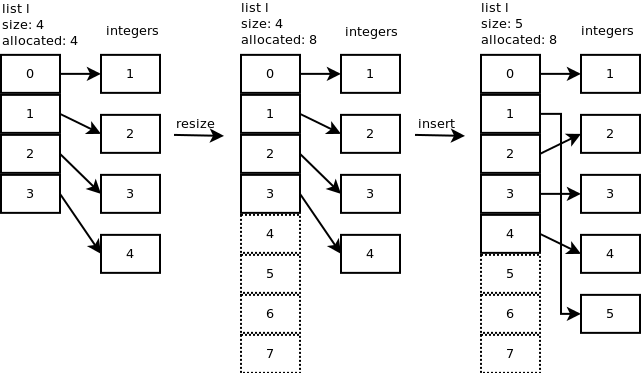I am always fascinated about programming languages, computer science and technology in general. At a dinner with my friends, we were discussing about programming languages Python, R, Fortran, C/C++ and data science. At a particular time, we were moving into an topic with a simple question how to implement linked-list in Python. For an experienced programmer like me, it is quite ridiculous for me to ask this question, because we do not need it in most cases. I think that Python will take care of basic data structures for you and you just use it. Python uses C to implement basic data structures for you, called CPython. And if you are crazy enough or want to reinvent the wheel or implement a new data structure, you can implement it in C/C++ and bind it to Python.
So, I spent that a whole night to rethink about a new question: What underlying implementation of Python container list [] and what is the equivalence containers/implementations in C++?
At first, I think the equivalent container in C++ would be vector. In the end, it has a slight difference in their implementation. The implementation of Python list uses a contiguous array of references to other objects, and keeps a pointer to this array and the array’s length in a list head structure. Some explanations can found at [1], [2]. The intuitive idea is represented through this simple picture.
 |
| Courtesy from Laurent Luce [2]. |
For me, Python is still new. And I think the best way to learn and understand a language is to ask simple and stupid questions like this. I have recently admired the development of Python language because it is motivated and evolved from exciting huge efforts of an open-source community.typedef struct { PyObject_HEAD Py_ssize_t ob_size; /* Vector of pointers to list elements. list[0] is ob_item[0], etc. */ PyObject **ob_item; /* ob_item contains space for 'allocated' elements. The number * currently in use is ob_size. * Invariants: * 0 <= ob_size <= allocated * len(list) == ob_size * ob_item == NULL implies ob_size == allocated == 0 */ Py_ssize_t allocated; } PyListObject;
Of course, the container are quite an important concept of a programming language. The container in Python includes list, tupple, dict, string and something else. The container in C++11 includes vector, list (equivalent to Python list), forward_list (single linked-list), map (similar concept to Python dict), unorder_map, deque (double linked-list queue), string, and something else.
Today, I have motivations to write blogs in Vietnamese. I decided that this blog is bilingual, i.e., English and Vietnamese. For me, it is easier to write technical contents in English, although Vietnamese is my mother tongue. It is because I tried to adapt to technical contents around Internet in English when I first came to learn computer science in university. Now, I find it hard to describe some technical concept in Vietnamese, especially with fast-pace changing field like Computer Science (CS). Overall, it is helpful because it is fun to contribute back to the community.
References:
[1] http://stackoverflow.com/questions/3917574/how-is-pythons-list-implemented
[2] http://www.laurentluce.com/posts/python-list-implementation/